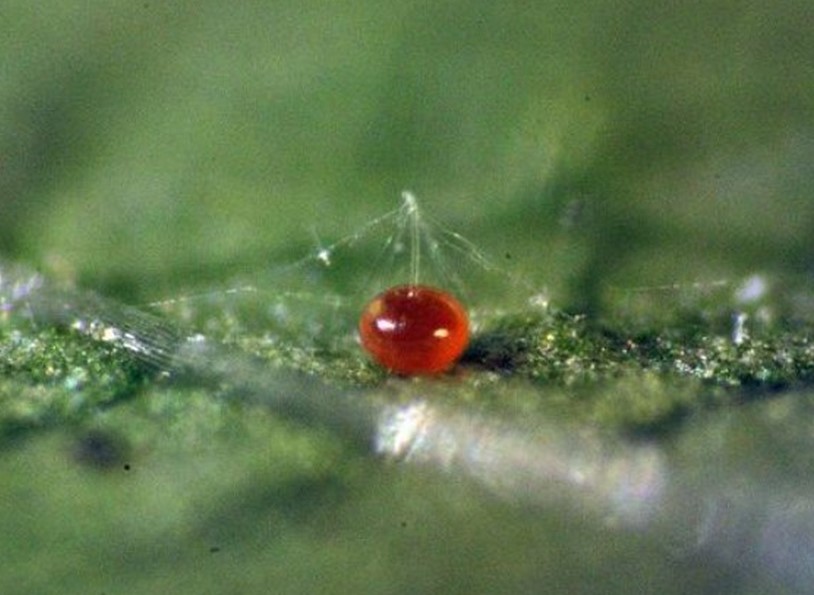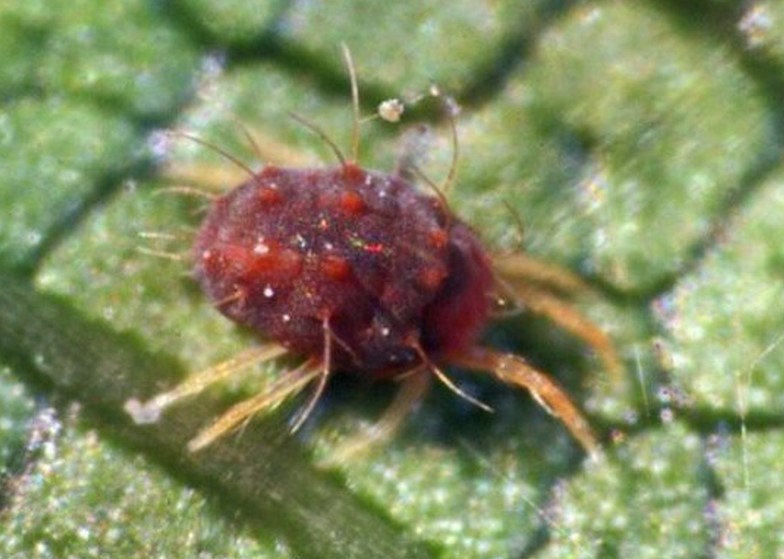Citrus red mite
Citrus red mite (Panonychus citri) is one of the world’s worst pests of citrus, but also feeds on roses, pears, almonds and some broadleaved ornamentals. Heavy infestations can cause defoliation, fruit drop and twig and branch dieback. First recorded in Sydney in 1966, it has since established in the Central Coast region of New South Wales. Citrus red mite does not occur in Victoria.
Description
Egg
Eggs are very small (less than 0.15 mm), round and bright red in colour and not visible to the naked eye (Figures 1 and 2). Females lay their eggs on the surface of both sides of the host plant leaf surface, held in place with silken thread (Figure 2).
Juvenile (nymph)
Citrus red mite nymphs resemble smaller versions of the adult. They undergo 3 stages of development, initially emerging pale in colour and with 6 legs. This is followed by two 8-legged nymphal stages.
Adult
Adult female mites are up to 0.5 mm long, dark red to purple in colour and covered in long bristles (Figures 1 & 3). Males are slightly smaller and narrow towards the back of the body.
Adult female citrus red mites are oval and globular; the male is smaller with a tapered abdomen.



Feeding damage
Citrus red mites feed on leaves, preferring new light green foliage, green bark and fruit of any age. Their piercing and sucking mouthparts cause tiny grey or silvery spots on leaves known as stippling or silvering (Figures 4 and 5). This occurs primarily on the upper surface of the leaf, but also on green fruit, which results in a pale, bleached appearance. Affected mature oranges and lemons turn a pale straw yellow.
Light infestations do not show obvious symptoms on the host plant, with initial damage commonly seen at the base of the upper leaf surface. Severe infestations can lead to premature leaf fall, fruit drop, decreased vigour and twig and branch dieback.


Hosts
Citrus red mites are known to occur on around 90 plant species from 30 plant families, with citrus being the primary infested host. Common Murraya (orange jessamine) has been recorded as an alternative host.
Overseas, other recorded hosts of economic importance include almond, apple, avocado, banana, grapes, guava, olive, passionfruit, paw paw, peach, pear, pecan, persimmon, rose, soybean, star fruit, strawberry, tea and some broad-leaved evergreen ornamentals.
Life cycle
Citrus red mites have a five-stage life cycle – egg, larva, two nymphal stages and adult. Generation time from egg to adult varies depending on temperature and humidity and can be as short as 2 or 3 weeks in summer.
Females lay 2 or 3 eggs a day on the surface of leaves, with a total of 20 to 50 eggs in a lifetime.
The first 6-legged larval stage hatches anywhere between 8 to 30 days, depending on temperature, followed by two 8-legged nymphal stages. each lasting only a few days.
Adult female citrus red mites are oval and globular. The male is smaller with a tapered abdomen. Adults live up to 18 days.
Distribution and spread
Citrus red mite has a worldwide distribution, specifically in citrus-growing regions. It is thought to have originated in Asia and spread by global transportation of plant stock. In Australia, it is restricted to the New South Wales Central Coast and has not been recorded elsewhere. Movement of citrus red mite host material outside of the Citrus Red Mite Biosecurity Zone in NSW is restricted.
Mites are known to only walk short distances but may be spread longer distances by wind and movement on clothes, infested plant material and equipment.
Photo credits
Figure 1: Copyright javixu CC BY-NC 4.0
Figures 2, 3 and 5: Ferran Garcia Mari CC-ND-4.0
Figure 4: Scot Nelson CC BY 4.0
Reporting an unusual plant insect pest or disease
Report any unusual plant pest or disease immediately using our online reporting form or by calling the Exotic Plant Pest Hotline on 1800 084 881. Early reporting increases the chance of effective control and eradication.
Please take multiple good quality photos of the pests or damage to include in your report where possible, as this is essential for rapid pest and disease diagnosis and response.
Your report will be responded to by an experienced staff member, who may seek more information about the detection and explain next steps.
Report online